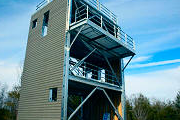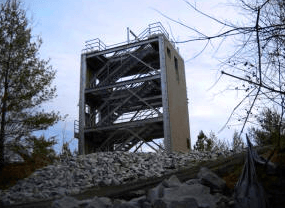Highpoint Police Training Tower
Highpoint, North Carolina

Leavitt Engineering, based in Nampa Idaho, recently completed the design for a new training facility for the City of High Point, North Carolina. This training tower will be located at the existing police shooting range in High Point. Captain Kenneth Shultz from the High Point Police Department asked Leavitt Engineering to help him design a shooting platform; however, he also wanted the structure to be versatile to include rappelling, rock climbing and other obstacles for training purposes. Project manager, J. Reese Leavitt, P.E./S.E. told Captain Shultz, “We can easily incorporate ladders, trap doors, scuttles, access hatches, cantilevered platforms, doors, windows, openings, a rope climb, obstacles, slides, a fire pole, helipad, or whatever your heart or mind can conceive or desires.” Based on Captain Shultz’s description of what he needed we initially developed and provided detailed conceptual hand sketches within a week
Police training towers are used to screen new job applicants to determine if they have the physical capabilities required to complete the unique tasks police officers perform. Various screening courses can be setup to test and measure applicant’s abilities to perform different types of tasks. Courses can be utilized to test, time and rank competing applicants.
Training towers are used to teach employees new skills and improve their existing abilities. Courses can measure employee’s physical condition and ability to perform required tasks.
They may also be used for team building opportunities. Courses can be designed with various tasks where teams are required to work together to solve problems to plan, execute and complete course tasks as a group.
Training towers can also be used to test employee’s abilities to continue to perform required skills. Various training courses can measure and rank employee’s performance and abilities. The course can be used to determine when an existing employee no longer has the physical abilities to perform certain basic tasks required for some job descriptions and responsibilities.

Various floor surfaces were proposed including concrete, synthetic wood and steel grating to simulate office, commercial, and industrial conditions. Synthetic wood, metal siding, brick and roof element surfaces for rappelling and climbing where suggested too replicate different types of wall surface conditions which may be encountered in the field. Ladders, cantilevered platforms, gates, trap doors, windows and other devices were added to provide simulated emergency ingress and egress under various access alternatives for training course and team building opportunities.
The training tower was designed as an open concentrically braced steel frame with an interior stair tower providing access to four training floors or levels. A three-dimensional structural frame design and analysis program, “Risa 3D”, was used to design and model the structure. The design can be easily modified in a 3D structural analysis model to add or remove training elements.
“Revit” by Autodesk was used to graphically display the building design model. A graphic model allows the user to quickly and easily visualize, revise, and pull data from the design model to implement design review and design changes. The graphic model also allows the designer, engineer and owner to review and analyze the model as the design progresses. Surprises are eliminated when clients can visually see the building model before construction begins. Design changes and corrections can be reviewed in the graphic model which leads to a more efficient and cost effective design. Design efficiency is what we strive for.
Leavitt Engineering provided a conservative cost estimate as the design was completed to insure the proposed design would meet budget requirements. Leavitt’s cost estimate was $168,500 which was within the City of High Points budget of $180,000. Bid alternates and adders included galvanized structural steel, ladders, platforms and trap doors. Six qualifying bids were received by the City of High Point with a low bid of $116,600 and a high bid of $168,000. The City of High Point was very happy the bids were well within their budget and Leavitt Engineering was happy their conservative cost estimate was on the high side of the bid range. Because of the favorable bid response, the City of High Point was able to include all of the bid alternates and adders in their project. No requests for additional information or clarification where requested from Leavitt Engineering during the bidding process. Leavitt Engineering has found that simple, clear and concise drawings, details and specifications make projects easier for clients and contractors to understand and build and benefit the client with lower cost bids.
Captain Shultz had negotiated with several contractors over a period of two years trying to develop a design plan which met his training needs and fit within his budget. Leavitt Engineering was able to help Captain Shultz develop this plan which accomplished his training objectives; prepare drawings, calculations and specifications; and offer this project for bids in just a few months.
The structure was designed with versatility to allow for future alterations to accommodate changing training requirements. Captain Shultz commented, ‘We have added two rope attachment points under the cantilever platform for rope climbing, added two attachment points on the third floor so we can go out the door on the rappel wall side as an intermediate level for guys new to rappelling and we added two trap doors so we can fast rope from the third level through the two grated floors to the ground level. We are very pleased with all the training options this structure provides us. We have been using left over funds budgeted for this project to pay for these additions.”
Captain Shultz commented, “We are very pleased with the architectural and engineering work provided by Leavitt & Associates Engineers, Inc. They were easy to work with and they were able to take my ideas and put them onto paper. After actually constructing the tower, the product is performing as expected and is providing us with a vast amount of training opportunities which we will be able to use to make our officers safer and more effective. Thank you for working with us to make this project successful.”
Leavitt Engineering has designed training towers and inclined walls for rappelling, rock climbing and fast roping for military installations throughout the US. Recent projects have been completed at Fort Richardson Alaska and the White Sands Missile Range in New Mexico.
Leavitt Engineering’s website, www.leavittengineers.com, allows them to show their design capability worldwide and the internet and modern technologies help them to communicate, design and build projects around the world.
Leavitt Engineering has business licenses and is licensed to practice engineering in all fifty states and Canada. Leavitt Engineering consults and provides engineering solutions worldwide.
Contact Info
Address:
1324 First Street South, Nampa, ID 83651
Phone:
(208) 463-0333
Fax: (208) 463-9040
How can we help you?
Call Jimmy Church or Reese Leavitt at
(208) 463-0333 or send an email to:
Jimmy Church: jrc@leavittengineers.com
Reese Leavitt: jrl@leavittengineers.com
Navigation
All Rights Reserved | Leavitt & Associates Engineers, Inc.
